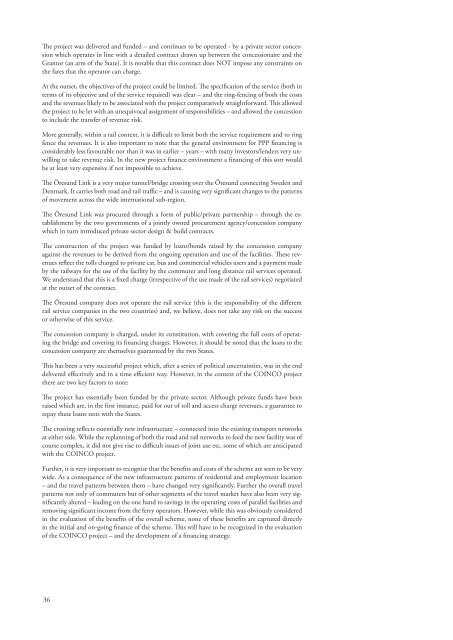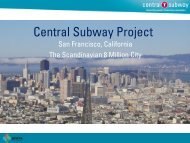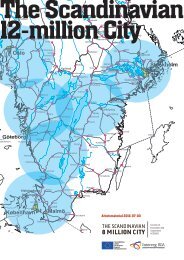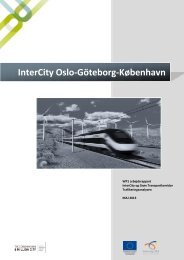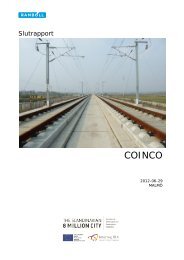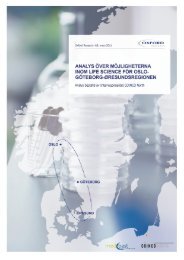Last ned The Scandinavian 12 million City - 8millioncity
Last ned The Scandinavian 12 million City - 8millioncity
Last ned The Scandinavian 12 million City - 8millioncity
- No tags were found...
You also want an ePaper? Increase the reach of your titles
YUMPU automatically turns print PDFs into web optimized ePapers that Google loves.
<strong>The</strong> project was delivered and funded – and continues to be operated - by a private sector concessionwhich operates in line with a detailed contract drawn up between the concessionaire and theGrantor (an arm of the State). It is notable that this contract does NOT impose any constraints onthe fares that the operator can charge.At the outset, the objectives of the project could be limited. <strong>The</strong> specification of the service (both interms of its objective and of the service required) was clear – and the ring-fencing of both the costsand the revenues likely to be associated with the project comparatively straightforward. This allowedthe project to be let with an unequivocal assignment of responsibilities – and allowed the concessionto include the transfer of revenue risk.More generally, within a rail context, it is difficult to limit both the service requirement and to ringfence the revenues. It is also important to note that the general environment for PPP financing isconsiderably less favourable nor than it was in earlier – years – with many investors/lenders very unwillingto take revenue risk. In the new project finance environment a financing of this sort wouldbe at least very expensive if not impossible to achieve.<strong>The</strong> Öresund Link is a very major tunnel/bridge crossing over the Öresund connecting Sweden andDenmark. It carries both road and rail traffic – and is causing very significant changes to the patternsof movement across the wide international sub-region.<strong>The</strong> Öresund Link was procured through a form of public/private partnership – through the establishmentby the two governments of a jointly ow<strong>ned</strong> procurement agency/concession companywhich in turn introduced private sector design & build contracts.<strong>The</strong> construction of the project was funded by loans/bonds raised by the concession companyagainst the revenues to be derived from the ongoing operation and use of the facilities. <strong>The</strong>se revenuesreflect the tolls charged to private car, bus and commercial vehicles users and a payment madeby the railways for the use of the facility by the commuter and long distance rail services operated.We understand that this is a fixed charge (irrespective of the use made of the rail services) negotiatedat the outset of the contract.<strong>The</strong> Öresund company does not operate the rail service (this is the responsibility of the differentrail service companies in the two countries) and, we believe, does not take any risk on the successor otherwise of this service.<strong>The</strong> concession company is charged, under its constitution, with covering the full costs of operatingthe bridge and covering its financing charges. However, it should be noted that the loans to theconcession company are themselves guaranteed by the two States.This has been a very successful project which, after a series of political uncertainties, was in the enddelivered effectively and in a time efficient way. However, in the context of the COINCO projectthere are two key factors to note:<strong>The</strong> project has essentially been funded by the private sector. Although private funds have beenraised which are, in the first instance, paid for out of toll and access charge revenues, a guarantee torepay these loans rests with the States.<strong>The</strong> crossing reflects essentially new infrastructure – connected into the existing transport networksat either side. While the replanning of both the road and rail networks to feed the new facility was ofcourse complex, it did not give rise to difficult issues of joint use etc, some of which are anticipatedwith the COINCO project.Further, it is very important to recognise that the benefits and costs of the scheme are seen to be verywide. As a consequence of the new infrastructure patterns of residential and employment location– and the travel patterns between them – have changed very significantly. Further the overall travelpatterns not only of commuters but of other segments of the travel market have also been very significantlyaltered – leading on the one hand to savings in the operating costs of parallel facilities andremoving significant income from the ferry operators. However, while this was obviously consideredin the evaluation of the benefits of the overall scheme, none of these benefits are captured directlyin the initial and on-going finance of the scheme. This will have to be recognized in the evaluationof the COINCO project – and the development of a financing strategy.36


